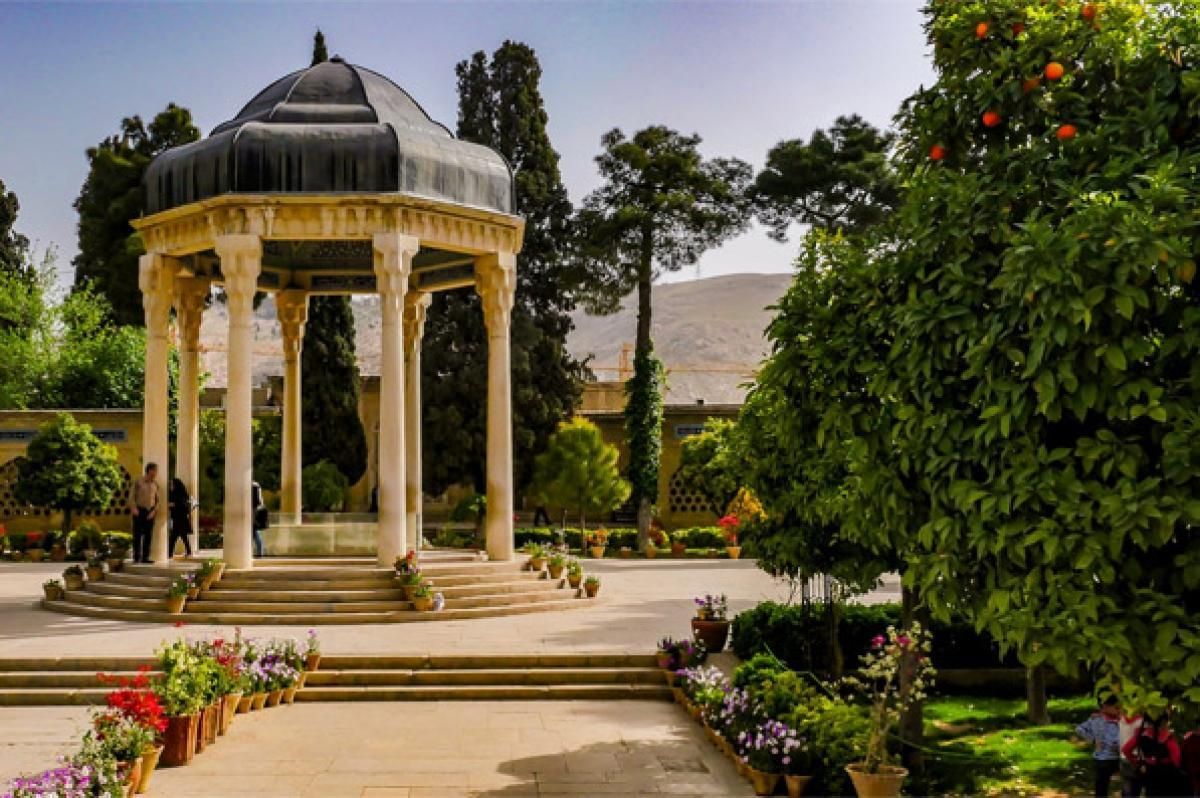Tomb of Hafez or Hafeziyeh, is the resting place of Hafez, one of the greatest Persian poets in the 14th-century. Hafez lived his whole life in Shiraz, and now is resting there in peace.
Who was Hafiz of Persia?
Shamsuddin Mahommed, known as Hafez is one of the most prominent Persian poets who lived in the 14th century. His poems are widely appreciated by the public and his verses are often recited. One of the interesting features of his poems is their divine and prophetic capability.
Many have ascribed his poems to Sufism. But in reality, critics find it hard to categorize him as a Sufi, philosopher, a mystic, wise man, poet or pessimist. His lyrical poems, called ghazal in Farsi, often include themes like the appreciation of the beloved, divine love, hypocrisy, and freedom.

What made Hafez, Hafez?
When talking to Iranian people, the chance of finding someone who does not know Hafez or has not heard of him is almost zero! Besides, there is almost in the house of every Iranian the book of Hafez’s ghazals. But what made Hafez, Hafez?
The word Hafez (memorizer) refers to someone who has something memorized, in this particular case, the Quran, the holy book of Islam. Hafez had not only the whole Quran memorized but also its 14 versions. As is in this verse of his:
To thy complaint, love reacheth, if like Hafez
Thou recite the Quran with the fourteen traditions.
In addition to his own claim, this could be found in his poems. In many ghazals, he directly or indirectly mentions Quran verses or Hadiths (the sayings of Prophet Mohammed and Imams).
Having said that, you may find it interesting that while reading his poems, you’d see that he talks quite a lot about wine and drinking! While drinking is forbidden in Islam. What’s more, he talks too much about love and beloved as well! That is indeed a question to some, which kinds of love he means, mundane or divine? Because, if you read his poems while having your very love in mind, it just makes perfect sense to you. As to the facts we just went through, the most probable explanation for this paradox is that he has his own language and uses words in his own way.
What Is Fal-e Hafez?
Fal-e Hafez is an act in which one would seek the answer to his/her question or ambiguity by opening the book of Hafez’s Ghazals. It is believed that since he had the Quran memorized, he could kind of see the future. That’s why people would consult Hafez as a tradition on some occasions such as Yalda. However, it is usually done for fun in friendly gatherings.
In order to take Fal-e Hafez, you first, should have your question or intention in mind, then open the book. The poem on the right page would be a guide to you. You must, however, keep in mind that understanding his poems thoroughly may not be as straightforward as you think, but the delicacies and profundity in his poems would definitely touch your soul.
Why see Hafez’s tomb?
As said before, Hafez’s poems reflect many realities about human beings. They are timeless, as readers have found them true for centuries on end. His wisdom has made its way into not only the people’s minds but also the Persian language. This is why he has enjoyed a respected and loved position among generations and generations of Iranians.
In addition to this, the tomb of Hafez is located in an enchanting garden that not only reflects the layout of world-famous Persian Gardens, but also captures the essence of Hafez and his world. Coming to Shiraz and not visiting his tomb will be such a waste. Don’t you agree?
Hafez Tomb Introduction
Tomb of Hafez is in Shiraz, in a short distance from the Quran Gate. The area was revered by the people of Shiraz, that is why many deceased people were buried here. Today, the area has become a garden, called Mossalla, cut off from the rest of the graveyard. His tomb has been renovated several times during the centuries that have come to pass. The most important reconstruction took place in 1935 when the famous French architect and archeologist Andre Godard was requested to build a mausoleum for the poet.
During this period, the area was once again divided into two sections (during the previous renovation this had already happened). A 56-meter-long and 7-meter-wide eiwan with 5-meter-high stone columns separates the two sides of the garden. The veranda was originally built in the 18th century and had only 4 columns, but it was expanded in the 20th century.

Gardens and Tourism
Shiraz is a city of vast gardens, with lush green areas. Many of these gardens are of such historical importance that they play an important role in the tourism industry of Iran. The Persian Garden has been officially registered as a UNESCO World Heritage. They were built as representatives of the Eden on the earth.
Now the gardens engulfing the Tomb of Hafez in Shiraz are gems of pure beauty and heavenly ambience. Walking through these gardens may enlighten the soul, and impart just the same feeling that Hafez’s poems create for the reader or listener. Tourists love exploring the garden and having a refreshing drink at the café located in the garden.
Northern apron
Hafez’s tomb and memorial hall are located in the northern garden. This section is 3000 square meters. After ascending the steps of the memorial hall, and entering the northern garden, you will find a beautiful monument built in the center of this garden. This is where the tomb of Hafez is located. This is actually what takes every traveler to the garden.
In the center of the northern garden, 5 circular steps slowly rise for 1 meter above the ground. On top of the steps, 8 stone columns stretch upward for 10 meters and meet a dome made by copper. The dome looks like a dervish’s hat. Step inside and look up. The ceiling is covered by exquisitely designed colorful mosaics. Under this mosaic replication of the heavens, is located the tomb of Hafez in a marble stone.
Memorial hall
Hafez’s memorial hall is an eiwan which separates the northern and southern gardens. Originally, it consisted of only 4 columns built in the 18th century. Later on, 16 columns were added to the structure. You will find verses of his poems hacked on these columns.

South courtyard
The garden’s entrance is located at the south. Once you enter, a beautiful garden will stretch in front of you. You will be greeted by orange orchards, flower beds, two symmetrical pools on two sides of the main passage, and streams of water. This southern courtyard is 9985 square meters and solemnly leads visitors to the norther garden, where the tomb of Hafez is located.
When can I visit Hafez’s tomb?
You can visit the Tomb of Hafez from 8:30 in the morning until 10:00 o’clock at night. The beauty of the area can be completely grasped in the morning. But the area gets exceptionally charming at night, when the tomb and the gardens are engulfed in the halo of soft lights.
Hafezieh tomb ticket price
The tickets are sold at the entrance, for 50000 tomans.
Architecture of Hafezieh
Hafezieh is a garden where the tomb of Hafez is located. The area includes a southern garden, a veranda with 20 columns, and the northern garden where you will find the tomb of Hafez.
Hafez Tomb Address
You can find the Tomb of Hafez by following this address:
Hafeziyeh, Hafeziyeh Street, District 3, Shiraz, Fars Province, Iran
FAQ
The Tomb of Hafez is open every day, from 8:30 am to 10 pm. On Sundays, Wednesdays, and Thursdays it is also open until 11:30 pm.
The entrance fee for foreign travelers is 50000 tomans. (Unfortunately, we cannot tell the price in a foreign currency, because of constant exchange rate changes).
The closest historical attractions of Shiraz to Hafezieh are Quran Gate, Khaju Kermani’s Tomb, and Haft Tanan Museum. On a relatively further distance are Eram Garden, Delgosha Garden and Saadieh (Tomb of Saadi). The other nearby locations include the Abuzar, Koohpaye, and Valiasr Parks.
The closest cafes and restaurants to Hafezieh include:
• Nik café and restaurant
• Noosh café
• Mahooni café
• Café Koucheh
• Abizh café restaurant
• Haft Khan restaurant
Some of the close hotels to the Tomb of Hafez include:
• Park Saadi Hotel
• Atlas Shiraz Hotel
• Persepolis Hotel
• Shiraz Grand Hotel
• Royal Shiraz Hotel
• Arg Hotel
• Zandiyeh Hotel
• Jahan Nama Apartment Hotel
• Homa Hotel



Comment (0)